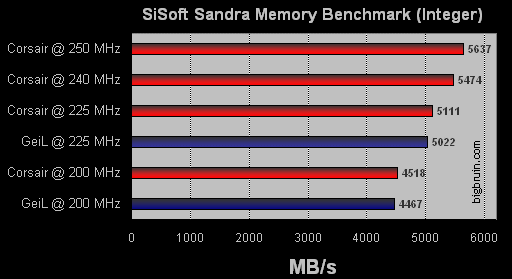|
 Posted: February 17, 2004 Posted: February 17, 2004
Author: Jason Kohrs
Manufacturer: Corsair
Source: Corsair
Components used in the review of the Corsair TwinX1024-4000PRO Memory:
• Intel Pentium 4 2.6C processor
• Abit IS7-G motherboard
• (2) 40 GB Maxtor DiamondMax Plus 8 hard drives in RAID O
• 420W Enlight dual fan power supply
• 24X CDROM
• Gigabyte 128MB Radeon 9600XT video card
• AMS gTower aluminum case
• Microsoft Windows XP Professional
In addition to the components above, the Corsair TwinX1024-4000PRO kit was compared with a dual channel kit of GeiL DDR400, pictured previously, and reviewed here. The installation was just as easy as it should have been, and the testing commenced immediately...
The first thing I wanted to test was the LED activity lights. In addition to showing that I can’t keep a camera still (even with a tripod), the below image details a bit of the animation of the Corsair LEDs. With a series of green, orange, and red LEDs, anyone can tell just how hard their memory is working. When idling, one may get a few green LEDs to light up, but as the activity increases, the bars light up the orange and then red bands, like a music equalizer with some serious beats pumping.

Definitely a novel feature, but to me it is more for the owner looking for a few more lights to shine through his window modded case. Once I snapped out of the hypnotic trance the blinking lights put me in, I proceeded to the serious portion of the testing, which consisted of running the following benchmarks:
• SiSoft Sandra Max3! Memory Benchmark (Integer)
• SiSoft Sandra Max3! Memory Benchmark (Float)
• PCMark 2002 Memory Benchmark
• PCMark 2004 System Benchmark
All phases of testing were run with the Corsair memory set to 2.7V and with the default settings of 3-4-4-8 confirmed in the BIOS when set to SPD. For comparison purposes, the GeiL memory mentioned was also run at 2.7V, and despite it being rated for faster timings at lower clock speeds, it was run at the 3-4-4-8 timings. Each benchmark was then run at four speeds on the Corsair memory (200 MHz, 225 MHz, 240 MHz, and 250 MHz) and at the two speeds where the GeiL could actually boot (200 MHz and 225 MHz). The Intel Pentium 4 2.6C isn’t as renowned for overclocking as the 2.4C, but it did overclock to a rather impressive 3315 MHz (13x255 MHz) on the Corsair TwinX1024-4000PRO. Stability seemed to max out around 250 MHz (most likely no fault of the memory, but due to the limitations of the processor), as PCMark 2004 would not run at any higher speeds, so that is where the benchmarking cap was established.
SiSoft Sandra Max3! Memory Benchmark (Integer):
This benchmarking module is an “information & diagnostic utility. It should provide most of the information (including undocumented) you need to know about your hardware, software and other devices whether hardware or software." It is a comprehensive program with a suite of thorough benchmarks that is available in one form as a free download. Sandra’s memory benchmark module provides two results, with units of MB/s, obtained by reading/writing large chunks of data to memory. Although both benchmarks are run in one test, I have separated the results for clarity. The ‘Integer’ results are available below...

As you can see from the chart above, the Corsair TwinX1024-4000PRO put up some respectable numbers across the board, especially when you compare it to the GeiL memory at the same speed and timings.
SiSoft Sandra Max3! Memory Benchmark (Float):
The other set of results obtained in the SiSoft Sandra Max3! Memory benchmark reflect the ‘Float’ scores, and are shown below...

As with the first half of the Sandra benchmark, the Corsair memory edges out the GeiL at the same clock speeds, and then continues to impress as the speeds are increased all the way up to 250 MHz.
Please read on to page three for more on the Corsair TwinX1024-4000PRO Memory... Next
Page 1 | Page 2 | Page 3 | Forum | Review Index
|